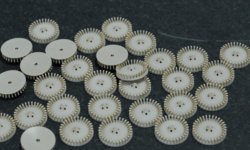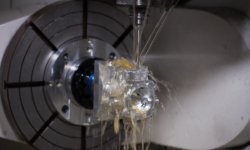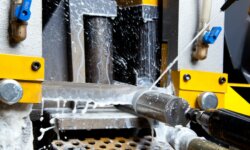Acrylic (PMMA) is a highly desirable material due to its strength, toughness, and transparency. But relying on conventional machining processes to cut acrylic can be a complicated procedure: the material is highly fragile and any excess force can cause unwanted breakages.
CNC machining, however, offers a reliable way to fabricate acrylic parts safely, with a high degree of accuracy and minimal waste of acrylic material. CNC machining results in very few errors, making it possible to create high-quality acrylic parts and prototypes such as headlamps, casings, jewelry, and more.
Advantages of acrylic machining
As a CNC machining plastic, PMMA or acrylic has many inherent benefits. And choosing to CNC machine acrylic instead of molding or 3D printing it can result in additional benefits. Some of the key advantages of machined acrylic include:
- Excellent transparency comparable to glass
- Excellent dimensional stability
- Good tensile strength and flexural strength
- Good level of insulation
- Abrasion resistance
- UV and sunlight resistance
- Lightweight compared to glass
- Good biocompatibility
- Relatively low cost
- Can be bonded with solvents
- Easy to polish
- Available in various colors
- Recyclable
Limitations or disadvantages of acrylic include its relatively low impact strength and brittle nature, as well as its average chemical and heat resistance. Polycarbonate (PC) is usually preferable for applications that require high impact strength.
Applications of acrylic machining
Machined acrylic has many industrial uses, with the material most widespread in the optical and automotive industries.
Glass alternative
Because of its excellent transparency and level of clarity, acrylic is used as a shatterproof glass alternative in many industries, including automotive, aerospace, and optical, where it is sometimes marketed under the brand name Plexiglass.
Acrylic is typically used as a glass alternative for window-type structures in aquariums, submarines, hockey arenas. It can also be used to make lighting parts like headlamps in the automotive industry. However, lamps intended for optical and automotive applications often assume complex shapes, and may also require very tight tolerances to deliver optimal performance.
The properties of PMMA also make it suitable for optical applications like eyeglass lenses and (less common nowadays) non-disposable contact lenses.
Medical and dental
Due to its good biocompatibility, acrylic can be used for various medical applications, including cosmetic surgery where it can function as an under-skin filler. Acrylic can also be used as a bone cement in orthopedic surgery, and for various uses in dentistry—dentures, for example.
Consumer goods
The cosmetic appearance of acrylic makes it suitable for a huge range of consumer products, from furniture to consumer electronics to musical instruments.
PMMA can be found in some LCD televisions, as well as in media like CDs and DVDs. It is also widely used for contemporary sculptures and artworks, being generally easier to manipulate than glass.
Machining acrylic vs 3D printing & injection molding
Acrylic is available in sheets and round stock and is highly amenable to CNC machining. However, it can also be processed using other fabrication technologies like 3D printing and injection molding.
When dealing with clear acrylic parts, CNC machining has one major advantage: it is the only way to achieve perfect transparency. It can also produce very fine details. Generally, machining acrylic is preferable for high-quality parts in low to medium volumes.
3D printing offers a few unique advantages over other processes, namely speed and geometrical flexibility. But the only process suitable for PMMA is FDM, and FDM 3D printers are typically worse than SLA printers (compatible with various resins) for making transparent or translucent parts.
Injection molding is the best acrylic manufacturing process for large quantities of parts, but offers less geometrical freedom than 3D printing and cannot produce parts as detailed or as clear as CNC machining. It provides good flexibility in terms of coloration.
Acrylic vs other clear plastics
Machined acrylic is desirable for its transparency, but Polycarbonate and ABS are potential alternatives to the material with their own unique advantages.
|
PMMA |
|
Brittle compared to PC |
|
PC |
|
|
|
ABS |
|
Harder to color than PC |
Considerations when machining acrylic
Acrylic is a useful and versatile material, but it can often succumb to failure when subject to compressive and tensile forces. This means that machining the desired shapes and cavities out of an acrylic panel needs a cautious approach.
However, the digital precision of CNC machining greatly simplifies this task. It also greatly increases the speed of acrylic machining, and the input parameters can be programmed to fit many needs.
Workholding
Plastic has different workholding requirements to metal, and acrylic is no different in this respect.
The material must be clamped tight in all areas, using either jigs and vises (smaller parts) or by affixing the entire part to the table (larger parts) with an adhesive. Budget permitting, a vacuum table is most suitable for acrylic machining, since it can clamp and unclamp the material effectively and without damage.
Machining
CNC machining acrylic typically demands an RPM of 15,000–20,000 with a stable feed rate. Too low a feed rate may result in heat buildup and chips sticking back onto the part, greatly reducing the quality of the surface finish.
Another way to prevent heat buildup is to pre-cool the acrylic feedstock before machining begins, facilitating better chip removal. During machining, oil-free coolants are preferable as they will not react with the plastic.
Post-processing machined acrylic
For a cosmetically satisfactory product, acrylic needs polishing after CNC machining, which creates the best possible clarity and light transmittance in the part.
This is usually done by manually polishing with a gradually finer-grit sandpaper followed by a linen towel and polishing paste. Flame polishing—exposing the machined acrylic to a flame from an oxyhydrogen torch, briefly melting the material’s outer surface—is another option for non-premium parts.
For high-quality prototypes such as automotive headlight lenses or taillight lenses, or windows for electronic products, polishing must be done by hand, and this job is reserved for the most experienced and skilled members of staff.
To create diffusion on a PMMA part, sandblasting and texture painting can be applied to the surface, while “milky” painting provides another aesthetic option. Alternatively, to color parts while maintaining their transparency, it is possible to paint and tint the parts after manual polishing.
Acrylic machining with 3ERP
Over the many years we have been involved in CNC machining, we have served many clients. And that diverse client base means that we have handled several complex procedures involving acrylic CNC machining.
Our staff has the skills that are needed to convert an acrylic panel into any desired shape and size. However, to ensure that our clients receive products that live up to their expectations, our professional engineers are happy to provide consultations. With this approach, we can be better placed to determine the needs of our clients and deliver CNC machined acrylic products with a guarantee of precision.
In addition to our skilled workforce, we have the right machines, cutting tools, and equipment to ensure that all of our work is of the highest quality.
Finally, all of the acrylic materials used at 3ERP have passed our selection tests, guaranteeing optimal performance. Our engineers and technicians thoroughly investigate the structural quality of any material that we take for consideration, and this approach has enabled us to produce machined acrylic products that can withstand the strain of their end use, no matter their ultimate purpose.
Machining acrylic optical components with 3ERP
Machined optical components such as lens assemblies and reflectors require a great deal of attention and precision. After years of research and dedication, 3ERP has been able to drastically improve the surface of CNC milled parts, the result being a surface as transparent as the hand-polished alternative while maintaining cohesion with other parts.
When it comes to multi-components optical parts, the closer the finished components are to the design, the better the components will fit together. However, acrylic components typically require extensive manual polishing, which increases smoothness and optical clarity but reduces the accuracy of fine features and can result in ill-fitting components.
Our breakthroughs in this area are the culmination of hard work and extensive testing with many different machines.
Our engineers worked with various cutters and cooling systems, trialling several sets of parameters, to come up with the best solution. Our precisely calculated acrylic machining techniques mean it is no longer necessary hand-polish optical components and risk altering the parts in small but deeply significant ways.







